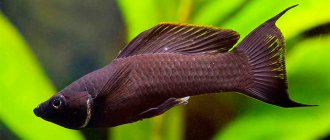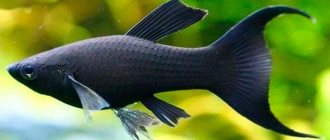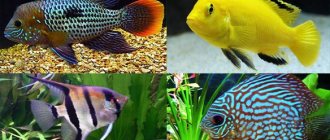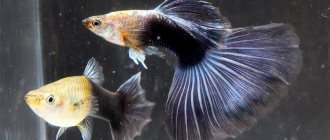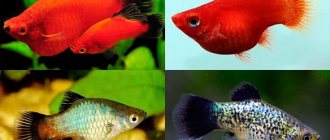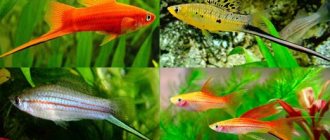Size
The most obvious sign is the size and shape of the abdomen. In females it is always a little larger, since in the future they will have to bear eggs.
It is important that the Danio’s tummy can stretch for other reasons: for example, in the case of a disease of the digestive system. Males can also suffer from such diseases, so you need to pay attention to the very shape of the abdomen. In “girls” the abdomen is evenly curved, while with the disease the anterior part of the body is significantly prominent.
Male above, female below.
Color
Another sign thanks to which you can easily distinguish males. “Boys”, as a rule, are colored more brightly and attractively, since they should attract the attention of “girls”.
Females, in turn, have a duller and more uniform color. Under natural conditions, pregnant females often hide from predators, so their faded coloring serves as their natural camouflage.
The photo shows that the veiled male Danio has a brighter color (the fish is below), unlike the female.
Behavior
In addition to their bright colors, males stand out for their character. “Boys” behave more active and mobile than “girls” - this is especially noticeable during the spawning period. Some individuals, as a rule, chase others or cut circles around them. It’s easy to guess that the male is the active partner, and the “victim” is the female.
Anal fin
Interestingly, male and female Danios differ in their anal fins. In females, this fin is larger and its edges are rounded. In “boys” the fin is pointed and its length is shorter than in females.
Unlike previous methods of sex determination, this sign is not as pronounced, so novice aquarists should not rely on it.
In the photo below, upon closer examination, you can see the difference in the anal fin of a female and a male; in an aquarium, when the fish are actively moving, it is very difficult to see this difference.
On the left is a male with a small anal fin and sharp edges, on the right is a female with a larger fin and rounded edges.
Experimental method
If you have doubts about your abilities and are not confident that you will be able to correctly determine the sex of all the fish, then you can conduct a simple experiment. Its essence lies in the fact that it is necessary to create conditions for Danio under which they prepare for spawning - thereby sexual dimorphism becomes more pronounced.
In nature, these tropical fish breed during the rainy season, when more small creatures appear in reservoirs and the water becomes warmer. Thus, to conduct the experiment, you just need to increase the water temperature (up to 24-25 °C) and feed the fish generously with live food .
After a few days, the females’ belly will noticeably increase in size, and the males will acquire an even brighter color and will move much more actively.
Other signs
Another sign can be considered the difference in the size of the fish’s bodies themselves. "Girls", as a rule, are somewhat larger and longer than "boys". This feature is explained by the need to bear eggs, which requires more physical effort and energy expenditure.
Example on Glofish fish, the female (right) is about 30% larger than the male. Same age.
Danio: what kind of fish is this?
The natural habitat of zebrafish is the waters of the Asian tropics, mainly India, Thailand and Burma. These fish belong to the large family of carp and the species of ray-finned inhabitants of freshwater bodies. In flocks in nature, they stay near the edge of the shore, merging with the coastal greenery.
Perhaps this fact played a decisive role in shaping the behavior and character of the fish: if the fish were lazy and slow, they would not survive off the coast.
At first glance, the zebrafish may seem too simple: a long (about 4.5-7 cm long) silvery body with longitudinal stripes of a predominantly blue or greenish hue. Because of these stripes, the fish were nicknamed “ladies’ stockings.”
The female has a more rounded belly, and the male has more developed fins.
The female has a more rounded belly, and the male has more developed fins.
Young individuals have short and rounded fins; with age, the fins become longer. The “face” of the fish can be called expressive: the upturned mouth, decorated with a pair of antennae, gives the zebrafish a cute expression. This anatomical feature gives them the ability to easily grab food from the surface of the water.
Externally, you can distinguish a male from a female: female zebrafish have a larger abdomen. And males have much more developed fins: they are larger and more powerful - especially the pectorals. And, as a rule, males are superior to females in gracefulness and brightness of color. The external gender difference is especially evident in the Burmese zebrafish species: females have a white stripe on their fins, while males have an orange stripe.
Nuances you need to know
It would seem that the given characteristics are quite sufficient to unambiguously establish the sex of a particular individual. In reality, these differences are quite difficult to notice, especially for inexperienced aquarists. The situation is further complicated by the fact that Danios are very mobile fish, so examining them is very problematic . In addition, certain nuances should be taken into account:
- the fish must not only be sexually mature, but also approximately the same in age (for example, a two-month-old “girl” cannot be distinguished from an adult “boy”);
- It is important to ensure regular and balanced feeding, as otherwise all individuals become emaciated, pale and lethargic.
Beginners are recommended to purchase several Danios so that they immediately form a school, and it is better to buy adult fish. If you plan to breed them, it is important to initially understand the sexual composition of the flock.
Science and zebrafish
The photo shows a Danio embryo that is only 72 hours old.
The photo shows a Danio embryo that is only 72 hours old.
Like the Drosophila fly, Danishka fish are especially loved by biologists and geneticists as model organisms. Why? Danios have significant advantages over many vertebrates: in just three days, a large and strong embryo grows from the egg, transparent in appearance, which makes it easier to observe its development.
This is interesting! It was zebrafish that were the very first fish to go into space!
In addition, although humans and fish have little in common, many systems of their organisms interact similarly with low molecular weight chemical compounds. This helps to reliably assess the toxicity and pharmacokinetics of the drugs being tested. And genetic engineers use zebrafish to study human diseases.
Feeding
Danios in their natural habitat use seeds of various plants, zooplankton, insects and larvae that have fallen into the water as food. At home, fish are absolutely not fussy about food. Both dry and live food are suitable for keeping them. The most favorite delicacies are bloodworms, Artemia and tubifex.
Fish need to be given small food , as they cannot swallow large pieces. The fish do not collect food from the bottom, because they spend most of their time in the upper layer of water and feed from its surface.
Aquarium zebrafish and fluorescent fish
Breeders have bred several species of zebrafish, differing in color and shape of fins. Main types:
The main types of Danio: Rerio (zebra), Tinwini, Pearl, Orangefin, Firefly (chopra), Black-striped.
The main types of Danio: Rerio (zebra), Tinwini, Pearl, Orangefin, Firefly (chopra), Black-striped.
Selected daniushkas differ from their ancestors in the color and shape of the pattern on the body. Dangil dangil is larger than other representatives, growing up to 9 cm in an aquarium. On the contrary, the chopra firefly is a small representative of the species - about 3 cm in size. Pink rerios have an unusually beautiful delicate color, and leopards, despite the “predatory” color of the body, are very peaceful and harmless.
Fluorescent fish have a bright, acidic color.
Fluorescent fish have a bright, acidic color.
Fluorescent fish are of particular interest. Unusual glowing zebrafish of unimaginable shades are the brainchild of genetic engineering. They are the first genetically modified organisms! The proteins of jellyfish and coral are built into their DNA; thanks to this, zebrafish glow in ultraviolet light. GloFish - modified fish are sold under this brand. By the way, trade in these species is prohibited in the European Union and Canada.
How does spawning work: the whole process from A to Z
The fish are released into a new aquarium in the evening, when it is clear that the female’s abdomen has become rounded. Most likely, breeding will begin at dawn. The fish mate within a few hours. But how does a zebrafish spawn? The mating season for zebrafish is quite interesting; they organize real love games: a pregnant female rushes around the aquarium, the males swim after her, trying to hit her on the abdomen with their tail. Thus, they help her get rid of eggs. This process continues tirelessly until the female runs out of eggs. During this time, one female can lay 100-200 eggs. As soon as the eggs fall into the water, the male fertilizes them. They sink to the bottom passing through the mesh. At the end of spawning, the spawners are placed in a common aquarium. After a few days (from 3 to 5), the fry are born.
Keeping at home
Even for beginners, caring for and maintaining zebrafish will not seem difficult. The unpretentiousness of these pets allows you to hone your aquarium skills on them, just as the hero of the famous Soviet movie honed the skill of using chloroform on porcelain cats (not literally!). Having learned how to care for zebrafish, you can safely move on to more capricious breeds, however, you are unlikely to part with zebrafish - they fit so harmoniously into the life of the aquarium.
To make keeping zebrafish comfortable in an aquarium, it would be good to calculate the volume of water. The larger it is, the better for these fidgets. For a small flock of 5-8 individuals, an aquarium of several tens of liters is ideal. It is also important to take into account the length: from 40 cm, and even better - from half a meter. In this case, the water temperature is needed from 17 to 25 degrees, but GloFish zebrafish are more thermophilic: they can only live at a temperature of about 28 degrees.
These fish need a spacious aquarium where they can frolic.
These fish need a spacious aquarium where they can frolic.
Even though zebrafish are river dwellers in nature, they can live without running water in captivity. Filtration of the aquarium and aeration will be required, as, however, it will not be possible to do without changing the water: you will have to replace a fifth of it weekly. You can use tap water, but it is recommended to let it sit. It would be good to clean the bottom once every 7-14 days. You also need to take into account the restless nature of the zebrafish: a lid on the aquarium will not hurt!
Zebrafish do not need special shelters or dense plants: these are schooling fish, they have no need to hide. There is a clearly defined hierarchy in the flock.
Danyushkas get along well with other non-aggressive inhabitants of the aquarium: swordtails, neons, guppies are good neighbors for them. But it is not recommended to introduce zebrafish closely to bettas, catfish, and angelfish. And shrimps and snails absolutely do not disturb the peaceful existence of these fish in the aquarium.
How long do zebrafish live on average? By fish standards, quite a long time: up to 7 years.
Why is this so important?
So, determining the sex of Danio is difficult, but still possible. First of all, awareness of sex differences is necessary for fish breeding. It is logical that it is difficult to get offspring if the flock consists of 5 males or 5 females.
In addition to this, it is important to ensure a quantitative advantage for the “boys” - only in this case will the Danios reproduce successfully. Finally, do not forget that Danios are schooling fish that cannot exist alone. Within each flock, a clear hierarchy is formed, which depends specifically on the number of females and males.
What to feed zebrafish
Danyushki are not gourmets at all: they are not picky about nutrition. It is possible to buy dry specialized food - well, among live ones, daphnia and bloodworms are excellent.
The principle is important: underfeeding is preferable to overfeeding. Excess food leads to rapid spoilage of water.
It is good to feed small portions of Danyushki a couple of times a day or once a day, but in the morning. The optimal calculation of the volume of food is carried out as follows: if, with repeated feedings per day, the fish eat everything within 3 minutes, there is enough food; for one-time feeding, the calculation is carried out in 5 minutes.
Female
It’s good if the beginner managed to notice how the fish spawned, and he was able to somehow mark it. Then this individual can simply be placed in the spawning area. It is more difficult when it is only the first offspring, or the female must be selected from the “herd” when purchasing.
The easiest way in this case is to focus on the size of the pink zebrafish. The female (adult) is larger than the male, she has a rounded belly, while the male is smaller in length and much thinner. According to this principle, you can only select adult fish of the same age, since the first few months a male zebrafish may be larger than representatives of this species.
If spawning does not occur immediately
If there was no spawning right away, there is no need to despair. The breeders can be kept in the spawning aquarium for another day. They should be fed with a small amount of small and well-washed bloodworms, avoiding in every possible way contamination of the water. If nothing happened the next morning, the fish again need to be divided by gender, keeping them in separate aquariums for about three to four days.
Important! All zebrafish are fish, the reproduction of which is an obligatory biological mechanism. To put it simply, if within a week after the first spawning attempt you do not place the female again to spawn, in 70% of cases she will lose the ability to reproduce.
Interesting Facts
- Malabar zebrafish eggs have one peculiarity: they are covered with special mucus and therefore not only fall to the bottom after spawning, but can also stick to algae leaves, aquarium walls and decorative items.
- Malabar danios sometimes mate for life and breed with only one partner.
- Representatives of this genus are surprisingly peaceful creatures. When they quarrel among themselves, they open their fins wider and begin to spin.
- There is a hierarchy in a school of Malabar zebrafish. The central place, as a rule, belongs to the strongest male. Further from the center is the place of weaker individuals. Their body is placed at a greater angle than the body of the leader (it swims almost horizontally).
Habitat
The zebrafish is native to the countries of South Asia. The wide range of this species includes Pakistan, India, Nepal, and Bangladesh. This small and agile fish is found in almost any body of water: rivers, streams, canals, ponds and lakes. The species is characterized by seasonal changes in habitats. During the rainy season, adult zebrafish are commonly found in flooded rice fields and large puddles. Here they look for food and lay eggs. Once the rainy season ends, they prefer to return to large permanent bodies of water.
Danio rerio are very hardy ornamental fish, so they are often kept by beginning aquarists. Indeed, to keep a minimum school of zebrafish (5-6 pieces), a 30-liter aquarium is quite enough. But the larger the volume, the more comfortable the zebrafish feel. The fish are very active and prefer to swim in the upper part of the aquarium. They can jump out of the water, so it is advisable to cover the aquarium with a lid or cover glass.
Danios love clean water, so care must be taken to ensure proper filtration and provide sufficient aeration. It is advisable to provide good lighting; with suitable lamps the fish will look brighter and more attractive.
Optimal water parameters for keeping: T = 17-25°C, pH = 6.7-7.0, GH = 6-15.
Regular water changes are required - 25-30% of the total volume. Long-stemmed plants are planted along the edges of the aquarium, the rest of the space is left for free swimming for the zebrafish.
Danio rerio in an aquarium with green plants
In suitable conditions, zebrafish can live 3-4 years.
Behavior
You can distinguish a boy zebrafish from a girl by their behavior. Having carefully observed your pets, it is easy to notice that some of them show increased activity, are more energetic and agile, while others prefer a somewhat measured pace of life.
If the fish behaves very playfully, then with a high degree of probability we can say that it is a male. Danio rerio boys are always more active than girls. They exhibit the greatest mobility during the breeding season. Energy and high speed provide them with leadership over competitors fighting for the female’s attention.
